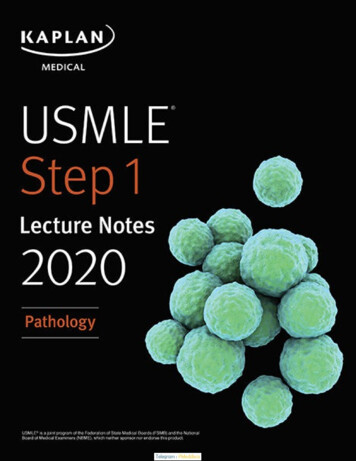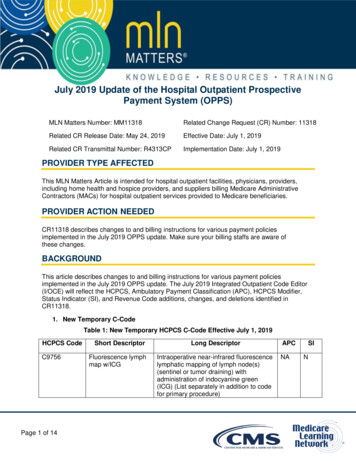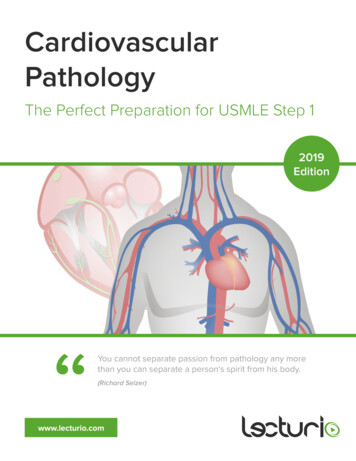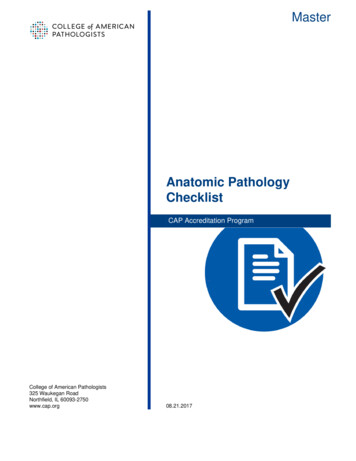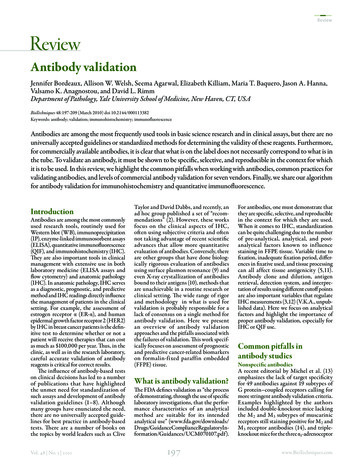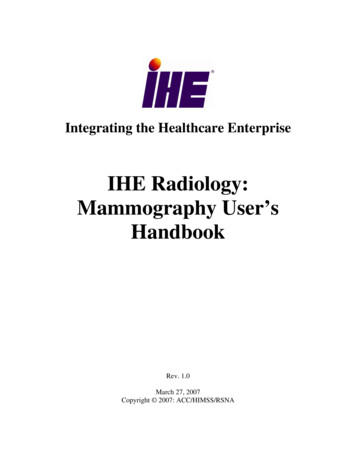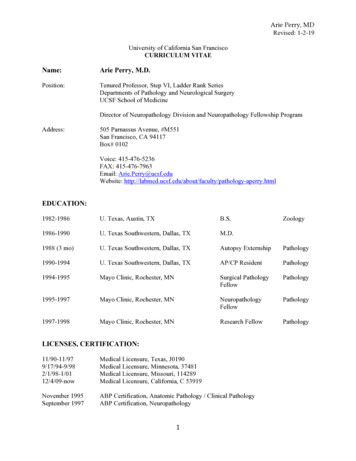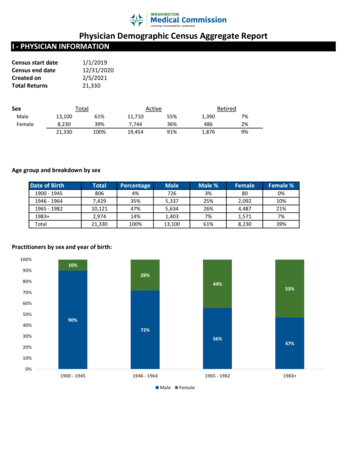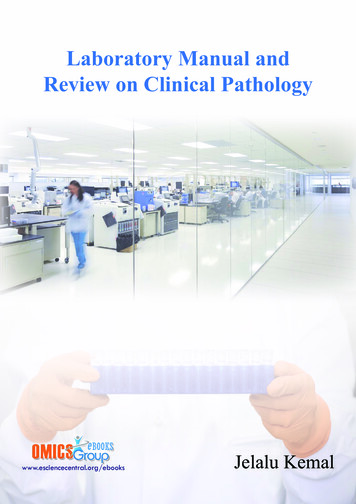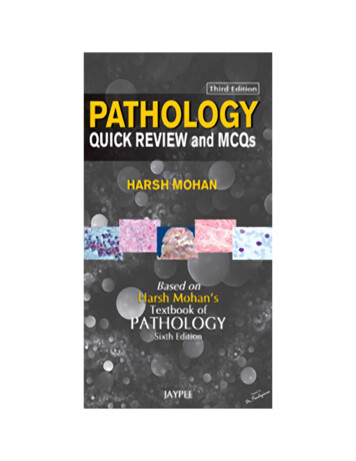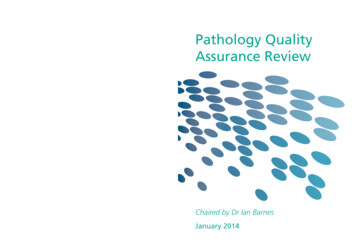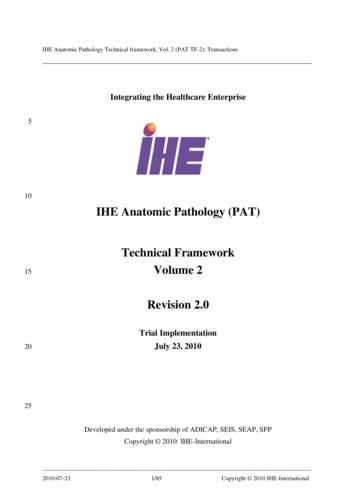
Transcription
IHE Anatomic Pathology Technical framework, Vol. 2 (PAT TF-2): TransactionsIntegrating the Healthcare Enterprise510IHE Anatomic Pathology (PAT)Technical FrameworkVolume 215Revision 2.0Trial ImplementationJuly 23, 20102025Developed under the sponsorship of ADICAP, SEIS, SEAP, SFPCopyright 2010: IHE-International2010-07-231/85Copyright 2010 IHE-International
IHE Anatomic Pathology Technical framework, Vol. 2 (PAT TF-2): ion . 51.1 Overview of the Anatomic Pathology Technical Framework . 51.2 Overview of Volume 2 . 61.3 Audience . 71.4 Scope introduced in the current year . 71.5 Comments . 71.6 Relationship to Standards . 71.6.1DICOM WG26 . 81.6.2HL7 Pathology Special Interest Group . 81.6.3International Health Terminology SDO (IHTSDO) . 81.6.4CEN TC 251 . 81.6.5Harmonization . 91.7 Relationship to Real-world Architectures . 91.8 Copyright Permission . 101.9 Open Issues regarding Volume 2 . 101.9.1Example messages to be provided . 101.9.2Vocabularies related to specimen . 102 Conventions . 112.1 The Generic IHE Transaction Model. 112.2 HL7 Profiling Conventions . 112.2.1Static definition - message level. 112.2.2Static definition - segment level . 122.3 HL7 Implementation Notes . 132.3.1Network Guidelines. 132.3.2Message Granularity . 132.3.3Acknowledgment Modes. 132.3.4Identifier Data Types . 132.4 DICOM Usage Conventions . 153 Common Message Segments . 173.1 MSH – Message Header segment . 173.2 NTE - Notes and Comment segment . 193.3 PID - Patient Identification segment . 203.4 PV1 - Patient Visit segment . 223.5 ORC Common Order segment . 233.6 TQ1 - Timing Quantity segment . 253.7 SPM - Specimen Segment . 263.8 SAC Container Detail segment . 293.9 OBX – Observation Segment . 303.10 Correlations of status between ORC, OBR, OBX . 344 Transaction PAT-1: Placer Order Management . 364.1 Scope . 364.2 Use Case Roles . 364.3 Referenced standards . 364.4 Interaction diagrams . 374.4.1Normal process of a placer order . 384.4.2Cancellation of an order by the Order Placer . 392010-07-232/85Copyright 2010 IHE-International
IHE Anatomic Pathology Technical framework, Vol. 2 (PAT TF-2): t or Cancellation of an Order initiated by the Order Filler . 394.4.4Replacement of an Order initiated by the Order Placer . 404.5 Messages static definitions . 404.5.1Restrictions on OML O21 message for transaction PAT-1 . 404.5.2OML O21 – static definition . 404.5.3ORL O22 static definition . 414.5.4Specific segments description for transaction PAT-1 . 425 Transaction PAT-2 - Filler Order Management . 465.1 Scope . 465.2 Use Case Roles . 465.3 Referenced Standards . 465.4 Interaction Diagrams . 475.5 OML and ORL Messages Static Definitions . 475.5.1Specific requirements for PAT-2 on ORC segment . 475.5.2Specific requirements for PAT-2 on OBR segment . 486 Transaction PAT-3 – Order Results Management . 496.1 Scope . 496.2 Use Case Roles . 496.3 Referenced Standards . 506.4 Interaction Diagram . 506.4.1Normal process for management of results of a filler order . 506.5 Message Static Definition . 516.5.1ORU R01 - Unsolicited Observation Message. 516.5.2Specific segments description for transaction PAT-3 . 526.6 Acknowledgement of ORU messages . 546.7 Actors responsibilities regarding the pdf report fac-simile . 546.7.1Order Filler responsibilities . 546.7.2Order Result Tracker responsibilities . 547 Transaction PAT-4: Procedure Scheduled and Update . 557.1 Scope . 557.2 Use Case Roles . 557.3 Referenced standards . 567.4 Interaction diagrams . 567.4.1Normal process of a procedure. 577.4.2Cancellation of a procedure by the Order Filler . 577.5 Messages static definitions . 577.5.1OML O21 – static definition . 577.5.2ORL O22 static definition . 587.5.3Specific segments description for transaction PAT-4 . 587.5.4Expected Actions. 598 Transaction PAT-5 – Query Modality Worklist . 608.1 Scope . 608.2 Use Case Roles . 608.3 Referenced Standards . 618.4 Interaction Diagrams . 618.5 Query Scheduled MWL Message . 618.5.1Trigger Events . 618.5.2Message Semantics . 612010-07-233/85Copyright 2010 IHE-International
IHE Anatomic Pathology Technical framework, Vol. 2 (PAT TF-2): Transactions1251301351408.5.3Expected Actions. 658.6 Receive Scheduled MWL Message . 658.6.1Trigger Events . 658.6.2Message Semantics . 668.6.3Expected Actions. 669 Transaction PAT-6 Modality Procedure Status Notification . 679.1 Scope . 679.2 Use Case Roles . 679.3 Referenced Standards . 689.4 Interaction Diagrams . 689.4.1Modality Procedure Started . 689.4.2Modality Procedure Ended . 69Appendix A: Attributes Consistency. 70A.1 Image Acquisition Integration critical Attributes . 70A.2 Evidence Documents Integration - critical Attributes . 75A.3 Context-critical Attributes . 76A.4 Consistency Data Model . 76Appendix B: HL7 Order Mapping to DICOM MWL . 792010-07-234/85Copyright 2010 IHE-International
IHE Anatomic Pathology Technical framework, Vol. 2 (PAT TF-2): Transactions1451 Introduction150Integrating the Healthcare Enterprise (IHE) is an initiative designed to stimulate theintegration of the information systems that support modern healthcare institutions. Itsfundamental objective is to ensure that in the care of patients all required information formedical decisions is both correct and available to healthcare professionals. The IHE initiativeis both a process and a forum for encouraging integration efforts. It defines a technicalframework for the implementation of established messaging standards to achieve specificclinical goals. It includes a rigorous testing process for the implementation of this framework,organizes educational sessions, exhibits at major meetings of medical professionals todemonstrate the benefits of this framework and encourage its adoption by industry and users.155160165170175180The approach employed in the IHE initiative is to support the use of existing standards, e.g.HL7, ASTM, DICOM, ISO, IETF, OASIS, CLSI and others as appropriate, rather than todefine new standards. IHE profiles further constrain configuration choices where necessary inthese standards to ensure that they can be used in their respective domains in an integratedmanner between different actors. When clarifications or extensions to existing standards arenecessary, IHE refers recommendations to the relevant standards bodies.This initiative has numerous sponsors and supporting organizations in different medicalspecialty domains and geographical regions. In North America the primary sponsors are theHealthcare Information and Management Systems Society (HIMSS) and the RadiologicalSociety of North America (RSNA) and the American College of Cardiology (ACC).IHECanada has also been formed. IHE Europe (IHE-EU) is supported by a large coalition oforganizations including the European Association of Radiology (EAR) and EuropeanCongress of Radiologists (ECR), the Coordination Committee of the Radiological and Electromedical Industries (COCIR), the Groupement pour la Modernisation du Systèmed'Information Hospitalier (GMSIH), the Société Francaise de Radiologie (SFR), DeutscheRöntgengesellschaft (DRG), the Euro-PACS Association, Società Italiana di RadiologiaMedica (SIRM) and the European Institute for Health Records (EuroRec), the Associationpour le Développement de l‘Informatique en Cytologie et Anatomie Pathologiques(ADICAP), the Spanish Health Informatics Society (SEIS), the Spanish Society of Pathology(SEAP) and the Société Française de Pathologie (SFP). In Japan IHE-J is sponsored by theMinistry of Economy, Trade, and Industry (METI); the Ministry of Health, Labor, andWelfare; and MEDIS-DC; cooperating organizations include the Japan Industries Associationof Radiological Systems (JIRA), the Japan Association of Healthcare Information SystemsIndustry (JAHIS), Japan Radiological Society (JRS), Japan Society of RadiologicalTechnology (JSRT), and the Japan Association of Medical Informatics (JAMI). The listpresented here is not closed and other organizations representing healthcare professionals areinvited to join in the expansion of the IHE process across disciplinary and geographicboundaries.1.1 Overview of the Anatomic Pathology Technical Framework185This document, the Anatomic Pathology Technical Framework (IHE PAT TF) is producedwith the help of these organizations: ADICAP (Association pour le Développement de l‘Informatique en Cytologie etAnatomie Pathologique) SEIS (Spanish Health Informatics Society)2010-07-235/85Copyright 2010 IHE-International
IHE Anatomic Pathology Technical framework, Vol. 2 (PAT TF-2): Transactions190195 SEAP (Spanish Society of Pathology) SFP (French Society of Pathology)The document defines specific implementations of established standards to achieveintegration goals that promote appropriate sharing of medical information to support optimalpatient care. It is expanded annually, after a period of public review, and maintained regularlythrough the identification and correction of errata.The current version, rev. 2.0 for Trial Implementation, specifies the IHE transactions definedand specified as of July 2010. The latest version of the document is always available via theInternet at:http://www.ihe.net/Technical Framework/index.cfm#pathology200205The IHE Pathology Technical Framework identifies a subset of the functional components ofthe healthcare enterprise, called IHE actors, and specifies their interactions in terms of a set ofcoordinated, standards-based transactions. It describes this body of transactions inprogressively greater depth.Volume 1 (PAT TF-1) provides a high-level view of IHE functionality, showing thetransactions organized into functional units called integration profiles that highlight theircapacity to address specific IT Infrastructure requirements.The current document, Volume 2 (PAT TF-2) provides detailed technical descriptions of eachIHE transaction used in the Anatomic Pathology Profiles. These two volumes are consistentand can be used in conjunction with the Profiles of other IHE domains.210215220The other domains within the IHE initiative also produce Technical Frameworks within theirrespective areas that together form the IHE Technical Framework. Currently, the followingIHE Technical Framework(s) are available: IHE Anatomic Pathology Technical FrameworkIHE Cardiology Technical FrameworkIHE Eye Care Technical FrameworkIHE IT Infrastructure Technical FrameworkIHE Laboratory Technical FrameworkIHE Patient Care Coordination Technical FrameworkIHE Patient Care Devices Technical FrameworkIHE Quality, Research and Public Health Technical FrameworkIHE Radiology Technical FrameworkWhere applicable, references are made to other technical frameworks, as stated in section1.6.3 of Volume 1.2251.2 Overview of Volume 2The remainder of Section 1 further describes the general nature, purpose and function of theIHE Anatomic Pathology Technical Framework.Section 2 presents the conventions used in this volume to define IHE transactions.230Section 3 specifies common HL7 message segments shared by the transactions of thistechnical framework.2010-07-236/85Copyright 2010 IHE-International
IHE Anatomic Pathology Technical framework, Vol. 2 (PAT TF-2): TransactionsSections 4 and after define transactions in detail, specifying the roles for each Actor, thestandards employed, the information exchanged, and in some cases, implementation optionsfor the transaction.235The appendices following the main body of this volume provide technical details associatedwith the transactions.1.3 Audience240The intended audience of this document is: Technical staff of vendors participating in the IHE initiative IT departments of healthcare institutions Experts involved in standards development Anyone interested in the technical aspects of integrating healthcare information systems.1.4 Scope introduced in the current yearThe IHE Technical Framework is updated annually to reflect new profiles, corrections andnew transactions used in those profiles.245250255This document refers to 2009-2010 cycle of the IHE PAT Infrastructure initiative. It is thesecond release of this technical framework, and will be the basis for the 2011 Connectathonprocess and associated exhibition process.This release 2 of IHE PAT TF-2 results from the integration of the following ChangeProposals to the APW profile: CP18-PAT-APW (Antonio Gonzalez): Adding transaction PAT-6 ―Modality ProcedureStatus Notification‖. CP20-PAT-ARPH APW (François Macary & Ted Klein): Correction of ORU messagestatic definition (missing segment group ―PATIENT RESULTS‖ restored, as well asNTE segment following OBR)1.5 CommentsADICAP, SEIS, SEAP, SFP welcome comments on this document and the IHE initiative. Theyshould be directed to co-chairs:260265Dr Christel DANIELINSERM U872 eq 20,15 rue de l‘école de médecine75006 – PARIS. FRANCEchristel.daniel@spim.jussieu.frDr. Marcial García RojoHospital General de Ciudad RealAvda Tomelloso s/n13005 - Ciudad Real. SPAINmarcial@cim.esThomas SchraderDeparment of Pathology, ChariteChariteplatz 110117, Berlin. GERMANYthomas.Schrader@computer.orgComments may also be addressed to the IHE Anatomic Pathology international mailing .com1.6 Relationship to Standards270The IHE Technical Framework identifies functional components of a distributed healthcareenvironment (referred to as IHE actors), solely from the point of view of their interactions inthe healthcare enterprise. At its current level of development, it defines a coordinated set oftransactions based on ASTM, DICOM, HL7, IETF, ISO, OASIS and W3C standards. As the2010-07-237/85Copyright 2010 IHE-International
IHE Anatomic Pathology Technical framework, Vol. 2 (PAT TF-2): Transactionsscope of the IHE initiative expands, transactions based on other standards may be included asrequired.275280In some cases, IHE recommends selection of specific options supported by these standards;however, IHE does not introduce technical choices that contradict conformance to thesestandards. If errors in or extensions to existing standards are identified, IHE‘s policy is toreport them to the appropriate standards bodies for resolution within their conformance andstandards evolution strategy.IHE is therefore an implementation framework, not a standard. Conformance claims forproducts must still be made in direct reference to specific standards. In addition, vendors whohave implemented IHE integration capabilities in their products may publish IHE IntegrationStatements to communicate their products‘ capabilities. Vendors publishing IHE IntegrationStatements accept full responsibility for their content. By comparing the IHE IntegrationStatements from different products, a user familiar with the IHE concepts of actors andintegration profiles can determine the level of integration between them.285Two specific Pathology working groups dedicated to anatomic pathology have been recentlycreated within DICOM and HL7. Moreover, in Europe, Technical Committee CEN/TC 251dealing with ―Health informatics also addresses some issues related to anatomic pathology. Atlast, SNOMED CT is a de facto international terminology standard now maintained by theInternational Health Terminology Standards Development Organization (IHTSDO).2901.6.1 DICOM WG26The group will be responsible for formulating components of the DICOM standard that relateto imaging for Pathology.295Some pathology-related image formats do not as yet have applicable DICOM InformationObject Definitions. Examples include whole slide images (WSI), high-order multispectralimages, flow cytometry, electron microscopy.1.6.2 HL7 Pathology Special Interest GroupThe group will achieve a complementary effort, focusing on the "orders and observations"aspects of the pathology workflowHL7 Pathology Special Interest Group international mailing list: pathology@lists.hl7.org3001.6.3 International Health Terminology SDO (IHTSDO)305This group is integrated with internal staff from SNOMED International and externalcollaborators. They define new terms and establish relationships between accepted terms.There is a need to define the best way to integrate SNOMED Clinical Terms in anatomicpathology information systems (SNOMED CT value sets), and how to exchange informationwith other clinical departments and other institutions, using a common terminology.1.6.4 CEN TC 251310The document TC 251 Work Item 130.( Health informatics — Service request and reportmessages), prepared under mandate M/255 given by the European Commission and theEuropean Free Trade Association, has been prepared by Technical Committee CEN/TC 251―Health informatics‖, and has replaced the previous standards ENV 1613 (Medicalinformatics - Messages for exchange of laboratory information)., ENV 12538 (Medicalinformatics - Referral and discharge messages), and ENV 12539 (Medical informatics Request and report messages for medical service departments). The scope of the messages2010-07-238/85Copyright 2010 IHE-International
IHE Anatomic Pathology Technical framework, Vol. 2 (PAT TF-2): Transactions315320specified by this European standard comprises healthcare service requests and reports relatedto investigations carried out by healthcare service providers on subjects of care. They coverelectronic information exchange between computer systems used by healthcare partiesrequesting the services of healthcare service providers.Typical use cases are available by CEN TC251 in prEN 14720-1:2003 (Health informatics —Service request and report messages — Part 1: Basic services including referral anddischarge, TC 251 WI 130.1.1:2003 – E. See: http://www.centc251.org/): 325 330Service to be performed on specimens supplied by the requesterServices that require scheduling prior to the receipt of the sample collected by therequester (frozen sections, renal biopsy)Services performed on samples collected by the service provider (fine needle aspiration)Services in which the subject of care is examined by the service providerServices involving evaluation of an existing sample or study product (second opinion)Modification of an existing request following any of the above scenarios (additionalinvestigations or revised clinical information)Cancellation of an existing request following any of the above scenariosScheduling: See section B.2.3 Services that require scheduling prior to the receipt of thesample collected by the requester in CEN TC-251 WI 130 Part 1 (examples: frozen sectionand renal biopsy).1.6.5 Harmonization335It is important that the parallel efforts of IHE-pathology initiative and standardization bodies(DICOM WG 26 and Pathology Special Interest Group being formed for HL7, IHTSDO, andCEN CT 251 – be harmonized, , each one with its own purpose and organizational context.Clearly there will be overlap in defining the information model for specimens, instandardizing reports including quantitative measurements and assessments made withreference to images, etc.340Information model for specimens and templates for structured reports should be established incommon across both HL7 and DICOM standards.HL7-DICOM interoperation in anatomic pathology will be addressed in a HL7-DICOM jointworking group (HL7 Pathology SIG / DICOM WG26) defining clauses for harmonization ofstandards.3453503551.7 Relationship to Real-world ArchitecturesThe IHE actors and transactions described in the IHE Technical Framework are abstractionsof the real-world healthcare information system environment. While some of the transactionsare traditionally performed by specific product categories (e.g. HIS, Clinical Data Repository,Radiology Information Systems, Clinical Information Systems or Cardiology InformationSystems), the IHE Technical Framework intentionally avoids associating functions or actorswith such product categories. For each actor, the IHE Technical Framework defines onlythose functions associated with integrating information systems. The IHE definition of anactor should therefore not be taken as the complete definition of any product that mightimplement it, nor should the framework itself be taken to comprehensively describe thearchitecture of a healthcare information system.2010-07-239/85Copyright 2010 IHE-International
IHE Anatomic Pathology Technical framework, Vol. 2 (PAT TF-2): Transactions360365The reason for defining actors and transactions is to provide a basis for defining theinteractions among functional components of the he
of Radiological Systems (JIRA), the Japan Association of Healthcare Information Systems Industry (JAHIS), Japan Radiological Society (JRS), Japan Society of Radiological Technology (JSRT), and the Japan Association of Medical Informatics (JAMI).
